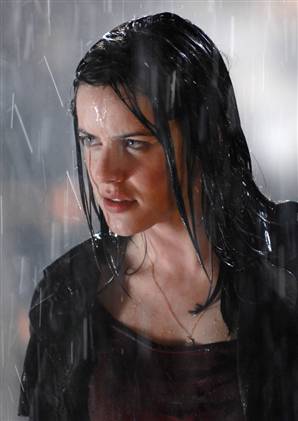Spoiler Alert!
I’ll let you in on a little secret regarding the new NBC series Bionic Woman: they’re all bionic on that show, every last one of them. Sure, the premise centers primarily on one technologically-augmented body, that of Jaime Summers (Michelle Ryan), a bartender injured so severely in a car crash that her boyfriend — an imaginative combination of your standard TV hot guy and your standard mad scientist; think McBrainy — promptly replaces both of Jaime’s legs, one arm, one eye, and one ear, with $50 million worth of bionic machinery, making her about 65% superhuman. The show, a remake or, I suppose, reboot of the 1976-1978 series that starred Lindsay Wagner in the title role, does go one step further by providing a nemesis/doppelganger in the form of Sarah Corvus (Katee Sackhoff), a previous experiment in bionic integration who, either through bad character or having been “hacked,” has become a murderous tormenter of the nameless paragovernmental organization where Jaime now works. (Corvus is also sultry and talks like a film noir femme fatale, but it’s unclear to what degree these traits preceded her upgrade.)
But the truth, as I said before, is that everyone on the show is bionic, from Jaime’s boss Jonas Bledsoe (Miguel Ferrer) to her little sister Becca (Lucy Hale) to the extras that populate the backgrounds. This greater degree of bionicization reflects the enormous strides that have occurred in the field since the late 1970s; see Eric Freedman’s excellent Flow article for a recap. Nowadays, instead of simply tacking on a robotic limb or improved sensory organ here and there, bodies can be implanted with structuring quantities of generic and intertextual material, resulting in characters whose every look, gesture, and word of dialogue issues from another source. The cast of Bionic Woman has literally been stitched together from other TV shows, movies, and comic books — reconstituted like chicken beaks and hog parts into shiny pink hot dogs, repurposed like ground-up car tires into bouncy playground equipment.
And it doesn’t stop there. Internal memoranda leaked to me from showrunner David Eick’s office reveal the deeper layers of bionicization that make up the new series. The settings, while profilmically real enough in their own right, were all first used on other shows — as were the scripts, storylines, character arcs, action setpieces, and cliffhangers. In actuality, Bionic Woman is a postmodern breakthrough, the cutting edge in mashup culture. It exists purely as a composite of borrowed and recycled material, a house mix of C-level storytelling retrofitted from the efflux of the SciFi Channel, USA, and Spike, chopped and reedited into apparently new creative “product.”
My sources inform me that, while the pilot episode was assembled under human supervision, the duties of outputting new weekly 42-minute swatches of text has now been handed over entirely to a computerized system which uses sophisticated pattern recognition to dovetail one unrelated shot or scene to another in semi-plausible continuity. (A related algorithm keeps the editing lightning-fast, ensuring that any mismatches will flash by unnoticed.) There are still a few glitches in the system, evidenced by the second episode’s kludgy splice of two fundamentally incompatible stereotypes into one character (the teenage Becca): as those of us whose organic bodies passed through adolescence know, no one who gets in trouble for smoking pot in the dressing room could simultaneously burn with the dream of performing in her high-school talent show’s number from Annie Get Your Gun. It’s not simply a logical impossibility, but a paradoxical, reality-ripping snarl in the fabric of fictive spacetime. NBC troubleshooters have traced the problem to a dunderheaded subroutine that mistakenly blended Rory Gilmore (Alexis Bledel) from Gilmore Girls with Angela Chase (Claire Danes) from My So-Called Life. The techs say it shouldn’t happen again, but aren’t making any promises.
In the meantime, Bionic Woman will continue to unspool, following its own logic of recombination in blissful automaticity. I find the show more watchable than just about any of the other new offerings of the season, except for Kitchen Nightmares, which quaintly and cannily embeds at least one real person within its own bionic grammar — kind of an inside-out TV cyborg. Certainly Bionic Woman passes the test that Chuck didn’t or couldn’t, drawing me back for a second look. I encourage you to check out Bionic Woman, especially if you’re a fan, as I am, of the sorts of mesmerizingly random patterns that emerge from nonlinear, chaotic flow like lava lamps and screen savers.

